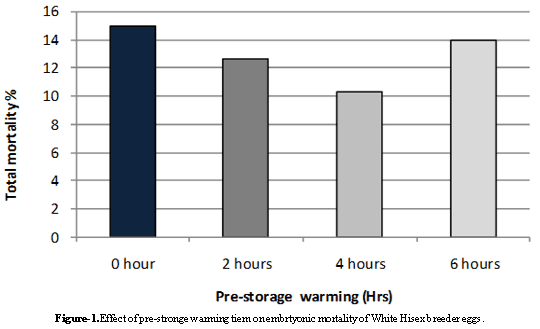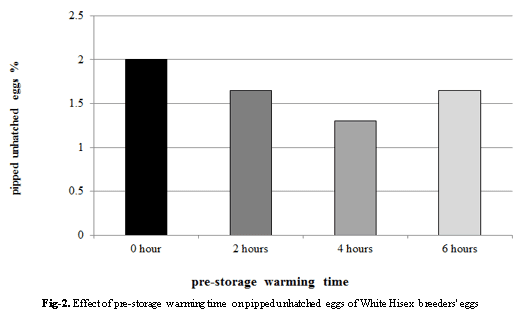Effect of Using Different Pre-Storage Warming Times on Hatchability of White Hisex Breeders’ Eggs
It is well known that commercial hatcheries set their eggs after days of storage which increases the incubation duration, decreases hatchability, chick quality and growth performance. The objective of this experiment was to study the effect of different pre-storage warming (PRESW) times on hatchability, embryonic mortality and chick grades of White Hisex layer breeders’ eggs. A total of 1200 eggs were collected from a flock at 67 weeks of age. Eggs were divided into four groups of 300 eggs each according to their warming time (0 hour as control, 2 hours, 4 hours and 6 hours, respectively). These groups were further subdivided into four replicates. of 75 eggs each and were assigned to the completely randomized design (CRD). Eggs were incubated at 37.5 °C. All eggs after warming were stored for two days in a cooler at 18 °C and a relative humidity of 75%, they were then incubated in (Pas Reform) setter for 18 days and hatcher for three days. At the end of the hatching process hatched chicks were graded (1st and 2nd grade chick); pipped - hatched eggs were then removed and counted. The remaining unhatched eggs were broken to determine fertility and embryonic mortality. Results indicated that pre-storage warming of hatching eggs at 37.5 °C for 4 hours significantly (P ≤ 0.01) reduced early dead embryos and total unhatched eggs. The first grade chicks were significantly (P ≤ 0.01) higher in pre-storage warming eggs. It is concluded that 4 hours PRESW improved hatchability percentage as it decreased embryonic mortality percentage, increased the number of saleable first grade chicks which by far increases profits.
Keywords: Breeder eggs, Fertility, Hatchability, Egg storage,unhatched, chick quality.
- True Fertility (%) = Number of fertile eggs ⁄ total number of eggs set X100
- Hatchability eggs set (%) = Number of chicks hatched ⁄ total number of eggs set X 100
- Hatchability of fertile eggs (%) = Number of chicks hatched ⁄ total number of fertile eggs X100
- Early phase mortality (%) = Number of embryos died in early phase/number of unhatched eggs X100
- Middle phase mortality (%) = Number of embryos died in middle phase/number of unhatched eggs X100
- Late phase mortality (%) = Number of embryos died in late phase/number of unhatched eggs ×100
- Pippedunhatched eggs (%) = Number of pipped eggs ⁄ total number of unhatched eggs ×100
- First grade chicks (%) = Number of first grade chicks ⁄number of chicks hatched×100
- Second grade chicks (%) = Number of second grade chicks ⁄number of chicks hatched×100 [12]





G. M. Fasenko, "Egg storage and the embryo," Poultry Science, vol. 86, pp. 1020-1024, 2007.
M. Petek and S. Dikmen, "The effects of pre-storage incubation and length of storage of broiler breeder eggs on hatchability and subsequent growth performance of progeny," Czech Journal of Animal Science, vol. 51, pp. 73–77, 2006.
L. Van De Van, "Storage of hatching eggs in the production process," International Hatchery Practice, vol. 18, pp. 27–31, 2004.
V. L. Christensen, J. L. Grimes, M. J. Wineland, and G. S. Davis, "Accelerating growth during incubation following prolonged egg storage. 1. Embryonic livability," Poultry Embryonic Science, vol. 82, pp. 1863-1868, 2003.
J. Ruiz and C. A. Lunam, "Effect of pre-incubation storage conditions on hatchability, chick weight at hatch and hatching time in broiler breeders," British Poultry Science, vol. 43, pp. 374-383, 2002.
O. Elibol, S. D. Peak, and J. Brake, "Effect of flock age, length of egg storage and frequency of turning during storage on hatchability of broiler hatching eggs," Poultry Science, vol. 81, pp. 945–950, 2002.
K. Tona, F. Bamelis, B. De Ketelaere, V. Bruggeman, V. M. B. Moreas, J. Buyse, O. Onagbesan, and E. Decuypere, "Effects of egg storage time on spread of hatch, chick quality, and chick juvenile growth," Poultry Science, vol. 82, pp. 736–741, 2003.
T. Marandure, G. H. Matondi, G. B. Nyamushamba, and B. Ganyani, "Effect of duration of pre-heating broiler breeder eggs on hatchability, egg weight and chick uniformity post hatch," Research Journal of Agricultural and Environmental Management, vol. 1, pp. 1-5, 2012.
S. Laurens, "Heating of hatching eggs before storage improves hatchability," World Poultry Magazine, vol. 18, pp. 24-25, 2002.
G. M. Fasenko, F. E. Robinson, A. I. Whelan, K. M. Kremeniuk, and J. A. Walker, "Pre- storage incubation of long-term stored broiler breeder eggs: 1. Effects on hatchability," Poultry Science, vol. 80, pp. 1406–1411, 2001.
K. K. Tona, O. Onagbesan, B. De Ketelaere, E. Decuypere, and V. Bruggeman, "Effects of age of broiler breeders and egg storage on egg quality, hatchability, chick quality, chick weight, and post-hatch growth to forty-two days," Journal of Applied Poultry Research, vol. 13, pp. 10–18, 2004.
C. Erensayin, Scientific technical of poultry. Broiler breeding and hatchability, 2nd ed. vol. 1. Ankra, Turkey: Nobel Publication, 2002.
SPSS statistical package for the social sciences, version 17.0. Chicago: SPSS Inc, 2008.
R. G. D. Steel, G. H. Torrie, and D. A. Dickey, Principles and procedures of statistics: A biometrical approach, 3rd ed. New York: McGraw Hill Book Comp. Inc, 1996.
A. Lotfi, K. Hatefinejad, A. S. Abedi, and H. Rasoolian, "Impact of egg pre-storage incubation on embryo mortality and hatching efficiencies in Japanese quail (Coturnixcoturnix Japonica)," International Journal of Agricultural Biology, vol. 13, p. 625, 2011.
F. H. A. Silva, D. E. Faria, K. A. Torres, D. E. FariaFilho, A. A. Coelho, and V. J. Savino, "Influence of egg pre-storage heating period and storage length on incubation results," Brazilian Journal of Poultry Science, vol. 10, pp. 17–22, 2008.
I. A. M. Reijrink, R. Meijerhof, B. Kemp, E. A. M. Graat, and H. Van Den Brand, "Influence of pre-storage incubation on embryonic development, hatchability, and chick quality," Poultry Science, vol. 88, pp. 2649–2660, 2009.
A. Lourens, R. Molenaar, H. Van Den Brand, M. J. W. Heetkamp, R. Meijerhof, and B. Kemp, "Effect of egg size on heat production and the transition of energy from egg to hatchling," Poultry Science, vol. 85, pp. 770 -776, 2006.
F. F. Abdel-Azeem, "Effects of using different pre-storage incubation warming times and storage periods on hatchability of quail eggs and subsequent growth of chicks," Egyptian Journal of Poultry Science, vol. 29, pp. 761–775, 2009.
T. C. Gamble, D. R. Ingram, and J. M. Dowden, "Pre-storage warming effects on hatchability of end-of-lay broiler breeder eggs," Poultry Science, vol. 89, pp. 49- 55, 2010.
M. Petek and S. Dikmen, "The effects of prestorage incubation of quail breeder eggs on hatchability and subsequent growth performance of progeny," Animal Research, vol. 53, pp. 527–534, 2004.
Some commercial broiler hatcheries in India do not have cool room egg holding facilities and pre warming facilities.They order and receive hatching eggs from remote areas involving long travel hours in trains and road transport. These are multi stage incubation practices. They receive the eggs, unpack them from the boxes, keep them in trays in a room adjacent to setter room where they transfer the eggs on setter trays and set the eggs on the same or next day.
These hatcheries often experience low overall hatch with many eggs removed as infertie at candling done on day 18 prior to transfer to hatchers, particularly in summer. In fact these are early or very early embryonic mortality due to transit stress but are broadly termed as infertiles blaming the breeder farm for the same.
Are there any suggestions for improving hatch performance under such field conditions?









